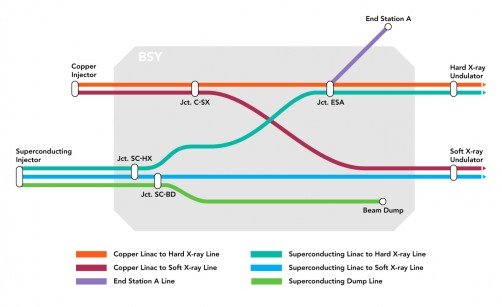
Popular Articles
- Earliest molecular events of vision revealed
- Dynamics and Kinetics in Structural Biology
- XFEL Pulses Demonstrate How Plants Perceive Light
- Structural biology is solved -- now what?
- BioXFEL Postdoctoral Fellowship Award
Archived Articles
- Details
- Friday, 07 July 2017

The central hub for powerful electron beams at the Department of Energy’s SLAC National Accelerator Laboratory is getting a makeover to prepare for the installation of LCLS-II – a major upgrade to the Linac Coherent Light Source (LCLS), the world’s first hard X-ray free-electron laser. LCLS-II will deliver the most powerful X-rays ever made in a lab, with beams that are 10,000 times brighter than before, opening up unprecedented research opportunities in chemistry, materials science, biology and energy research.
The hub, called the Beam Switch Yard (BSY), is a 600-foot-long section located at the east end of the lab’s historic 2-mile-long linear accelerator (linac), where high-energy electrons from the accelerator are redirected to experimental stations. These “electron trains” are reminiscent of the different lines of a metro system that connects various locations in a city. “The new BSY design clears the path for LCLS-II and allows the widest suite of options for the future X-ray laser,” says SLAC’s Scott DeBarger, manager of the BSY Reconfiguration Project. Today’s LCLS, a DOE Office of Science User Facility, uses a single electron line that starts at an electron injector at the beginning of the last third of the linac’s original copper accelerator and ends just beyond the LCLS undulator – a series of magnets that converts the electrons’ energy into ultrabright X-rays.
But the future facility will need more connections. In addition to the copper linac, LCLS-II will have a superconducting accelerator that will boost the X-ray laser’s firing rate to up to a million pulses per second. The current undulator will also be replaced with two state-of-the-art undulators for the generation of low- (soft) and high-energy (hard) X-rays. The BSY reconfiguration makes sure that both electron beams will be able to feed into either undulator, which requires four main lines. To give researchers at LCLS-II control over the rate of X-ray pulses in their experiments, another line can steer electron trains coming from the superconducting linac into a beam dump before they reach the undulators. A sixth line will lead to End Station A for experiments that use the extremely powerful electron beams directly.
SLAC mechanical engineer and system manager Jose Chan and his team designed the LCLS-II beamline that runs through the BSY reconfiguration area, including a vacuum chamber that ties the LCLS-II superconducting linac to the beamline from the copper linac currently used for the hard X-ray undulators.





